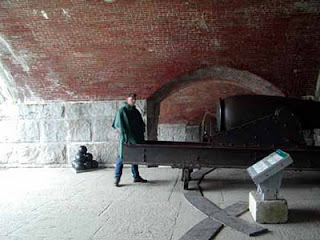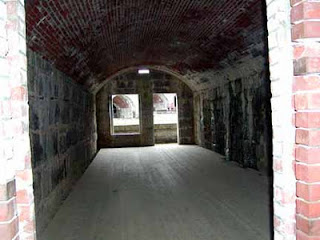The day after we went to the Fryeberg Fair we went to visit Fort Knox near Bucksport, Maine. It was pouring rain intermittently that day so it was a pretty damp visit!
 |
| View of Bucksport from above one of the cannon placements. |
 |
| Bucksport, Maine |
 |
| Cannon placements on the wall facing the Pencobscot River. | | | |
|
 |
| #1 son looking at one of the cannon ports from the outside that shows the metal doors being partially shut. Each port was designed to have a metal door shut between shots to the 'rammer' could ram the ball in place and not be shot by a sniper. |
 |
| #1 Son looking at a cannon from inside the cannon placements on the wall. The cannon could swing on the metal plates on the floor to aim it. After firing, it was slid back on the base, and a man had to ram in the powder and the cannon ball from in front of the cannon. After loading, the metal plates were opened again, the cannon slid forward through the port and re-aimed, and then fired. |
 |
| Parade ground inside the fort. |
|
|
|
|
 |
| Each arch had a room, the cannon rooms were the largest arches. This was room about the size of the enlisted men's barracks. The officer's each had a separate room this size with a fireplace. The enlisted men had no fireplaces. Apparently they did not deserve the luxury of heat. |
 |
| Fort Knox Amory. Today it serves as the Visitor Center. |
 |
| Civil War era ambulance. I cannot imagine the agony of having to lay in this thing and be transported while wounded. I'm sure more than one probably begged to be left to die. |
 |
| Entrance into the Fort from the outside |
 |
| Please take a close look at the ceiling of the arch in this photo and note it is made of brick. | |
|
|
|
Fort Knox (
HERE to read more) was built in 1844 to protect the Penobscot River Narrows. Bucksport had been previously occupied by the British twice. Once during the Revolutionary War and again during the War of 1812. It was one of several built during this time period, all built from the same plans in a pentagon shape. They were known as the Third System Forts. By the time they were built, they were obsolete as by 1861 they had developed cannons powerful enough to break through the masonry arches that served as the 'roof' for the fort. Remember the roof I wanted you to note?
Fort Sumpter in North Carolina was a Third System Fort. That means during the bombardment that began the Civil War, those men were being exposed to cannon fire raining down on their positions and in their living quarters. I find it amazing they managed to hold out for several days before surrendering the fort.
Fort Knox has never fired a shot but I don't believe the British ever wanted it again. :) It was interesting to visit and I'm glad we got to see it.










































